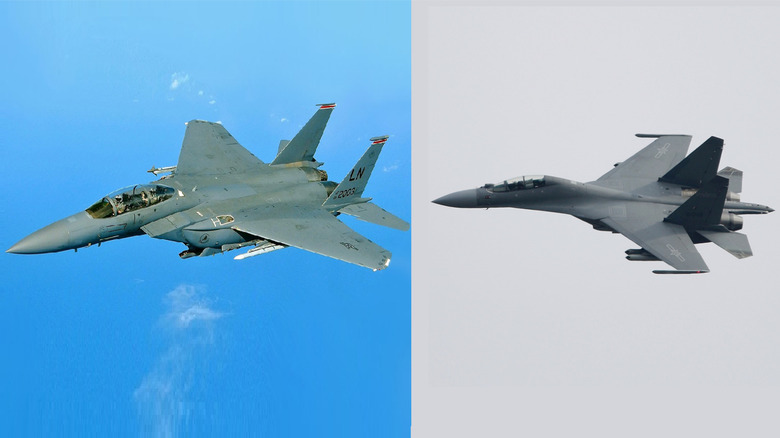What Is The Western Equivalent Of China's J-16 Fighter Jet?
The People's Republic of China possesses a formidable air force. Just how big it is depends on the metrics used to measure its size, but it's irrefutable that China has risen the ranks in recent decades. In terms of both sheer number of aircraft and the modernity of its tech, the combined strength of the People's Liberation Army Naval Air Force and the People's Liberation Army Air Force firmly places China's air force among the top three largest in the world. Its number of fighter jets is even nearing that of the United States, and several newer Chinese jet designs match the modernity of Western designs.
The Shenyang J-16, sometimes called the Qianlong, is one such model that sports all the technological strength of a 21st-century fighter jet. China introduced the J-16 fighter jet in 2013, though it wasn't until a few years later that the aircraft made its first official flight. The design was based on the Russian Sukhoi Su-30 jet, one of the most widely produced fighter jets in the world. However, the J-16 is far from a cheap imitation.
Because China's J-16 was based on a Russian design, Western equivalents are best assessed by comparing their performance. Several Western designs make the cut, including the United States' F/A-18E/F Super Hornet and the French Dassault Rafale. However, the U.S. F-15E Strike Eagle is ultimately the closest equivalent, since its capabilities are nearly identical to those of the J-16. The F-15E Strike Eagle also has several mechanical specs that closely match those of the J-16, including a similar range, a comparable maximum speed, and a near-equal munitions compatibility.
How the US F-15E Strike Eagle compares to the Shenyang J-16
Both the J-16 and the F-15E were designed for the same purpose: multirole strike fighting. The reason they're considered "multirole" aircraft is because both crafts are equipped to engage in air-to-air and air-to-ground combat. These capabilities are illustrated by each craft's munitions. The J-16's primary missile systems employ up to eight radar-guided missiles and four infrared-guided missiles. Similarly, the F-15E's primary missile systems are typically loaded with a maximum of eight missiles, with compatibility for a combination of both AIM-120 AMRAAM missiles and AIM-9 Sidewinders. While the Sidewinders are based on decades-old technology, they still use the same fundamental technology as modern short-range missiles, such as those in the J-16.
Their bomb missile systems for air-to-ground strikes are also strikingly similar. The J-16's bomb bay can deploy both laser-guided and satellite-guided bombs, which are linked to China's BeiDou satellite array. The F-15E can also carry such cargo. The United States Air Force website claims that the F-15E is capable of dropping "any air-to-surface weapon in the Air Force inventory," and that includes nuclear warheads. Information about the J-16's nuclear-delivery capabilities isn't quite as transparent, but it's almost certain due to the characteristics of the Soviet-era jet bomber on which the J-16 is based.
Although the J-16 debuted nearly 25 years after the F-15E, there's a reason the two fighter jets are so similar. In 1989, the United States introduced the F-15E Strike Eagle. In 1996, Russia introduced the Sukhoi Su-30, which was a clear equivalent to the F-15E in terms of technological modernity. Finally, in 2013, China introduced the J-16 fighter jet based on the design of the Su-30. Thus, there's a direct historical line between the two.
Other modern equivalents in the J-16 class
While the F-15E is the J-16's closest equivalent, there are other modern fighter jets worth mentioning that have similar specs to the J-16. One example is the Rafale French Multirole Fighter Aircraft. Designed for both air-to-air and air-to-ground strikes, it's another two-manned multirole fighter and one of the most commonly used fighter jets in the world. With a top speed of nearly 1,500 mph, it's slightly slower than the J-16's max speed of about 1,840 mph. However, the Rafale was given technological upgrades in 2018 to enhance its maneuverability and technology. Consequently, Chinese military experts were cited in 2025 stating that the J-16 is the French Rafale's "peer."
The J-16 has an electronic warfare variant, for which the United States has a rival. In the J-16D, the 30mm cannon and the IRST are absent. In their places, the J-16D hosts "electronic warfare pods" on the tips of its wings, which serve as radar jammers. The closest equivalent from the West is the EA-18G Growler. First commissioned to Boeing in 2004 by the U.S. Navy, the EA-18G Growler is a variant of the F/A-18F Super Hornet, fulfilling the same role as the J-16D in electronic warfare.
In fact, the original F/A-18F Super Hornet is another close equivalent to the J-16. A multirole jet designed for air-to-air and air-to-ground combat, the F/A-18F was a redesign by McDonnell Douglas to add more powerful engines and technological upgrades to its baseline model. That being said, the entire F-18 line represents such a drastic improvement over its predecessors, it's less closely aligned with the developmental history of the J-16. Of course, any fighter jet is eligible for upgrades, which is why the 35-year-old F-15E still stands as the newer J-16's closest equivalent.


